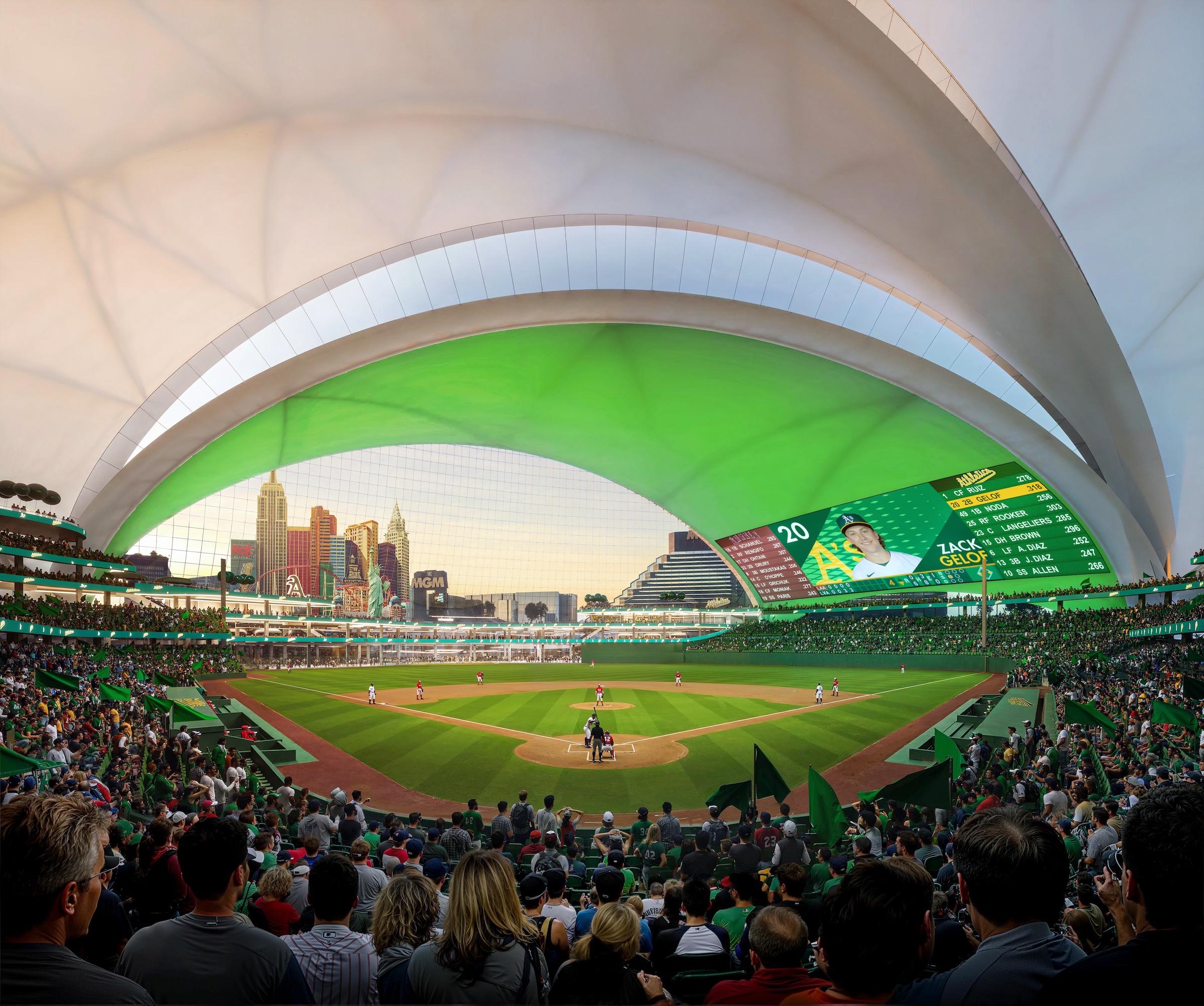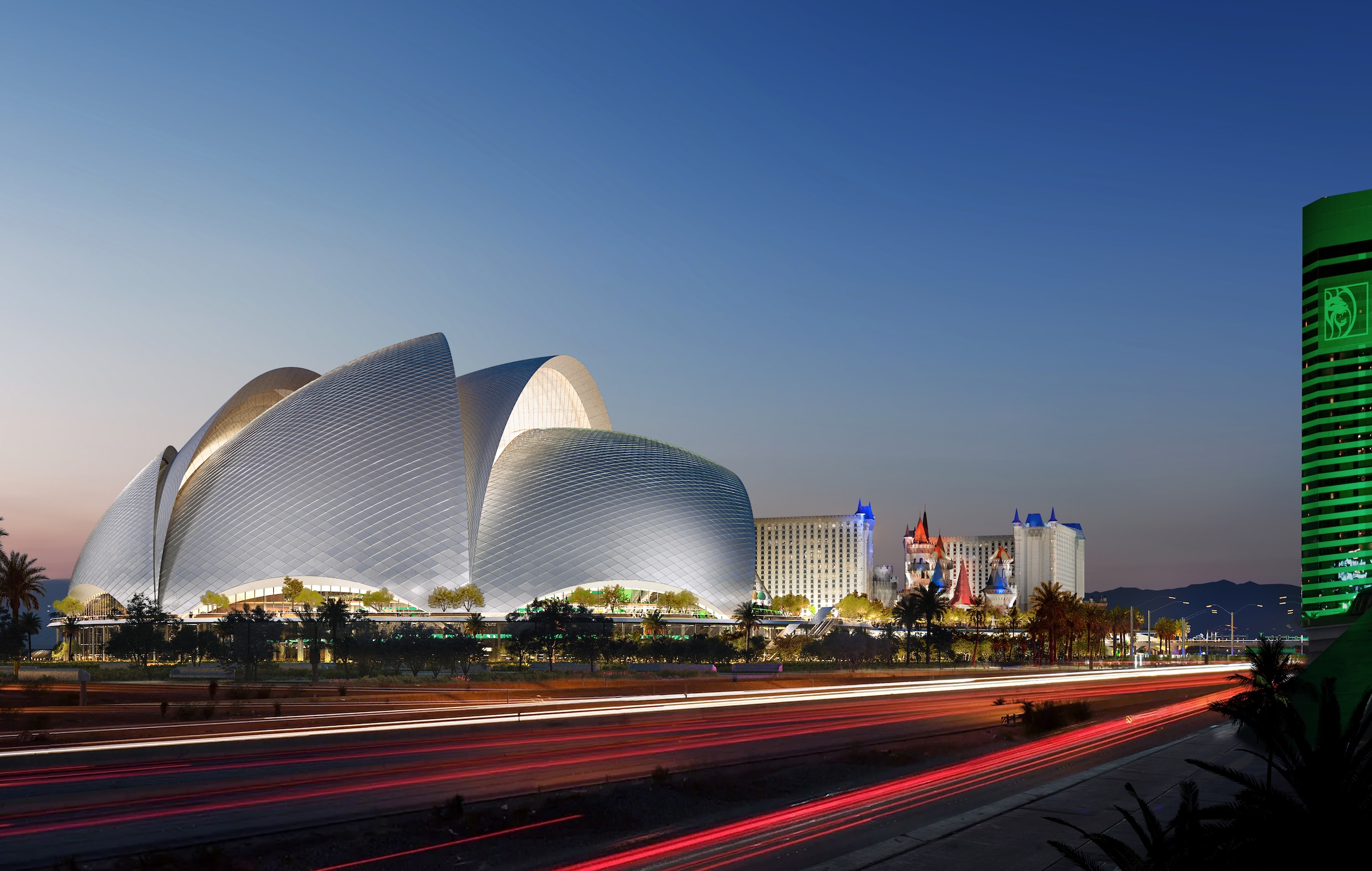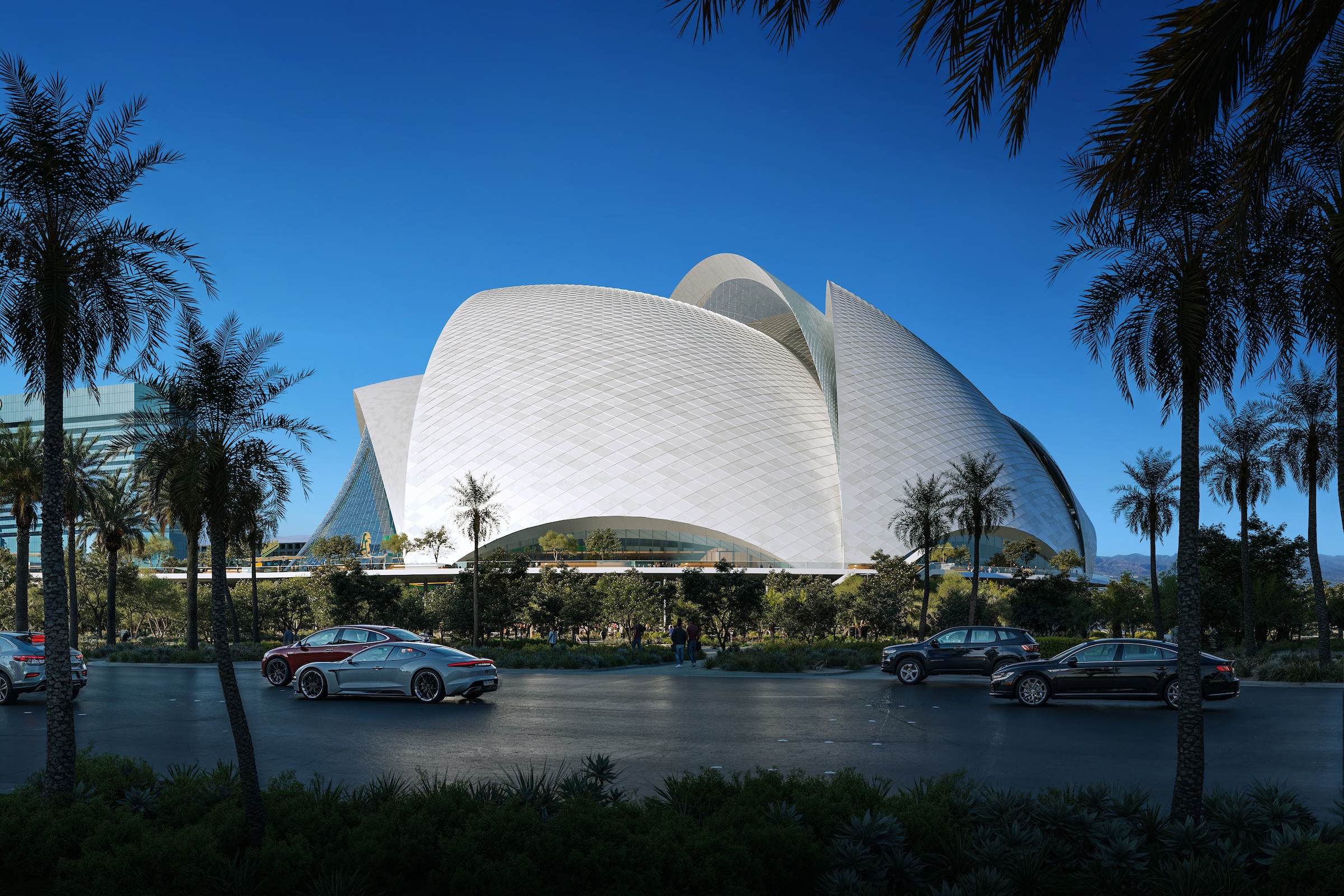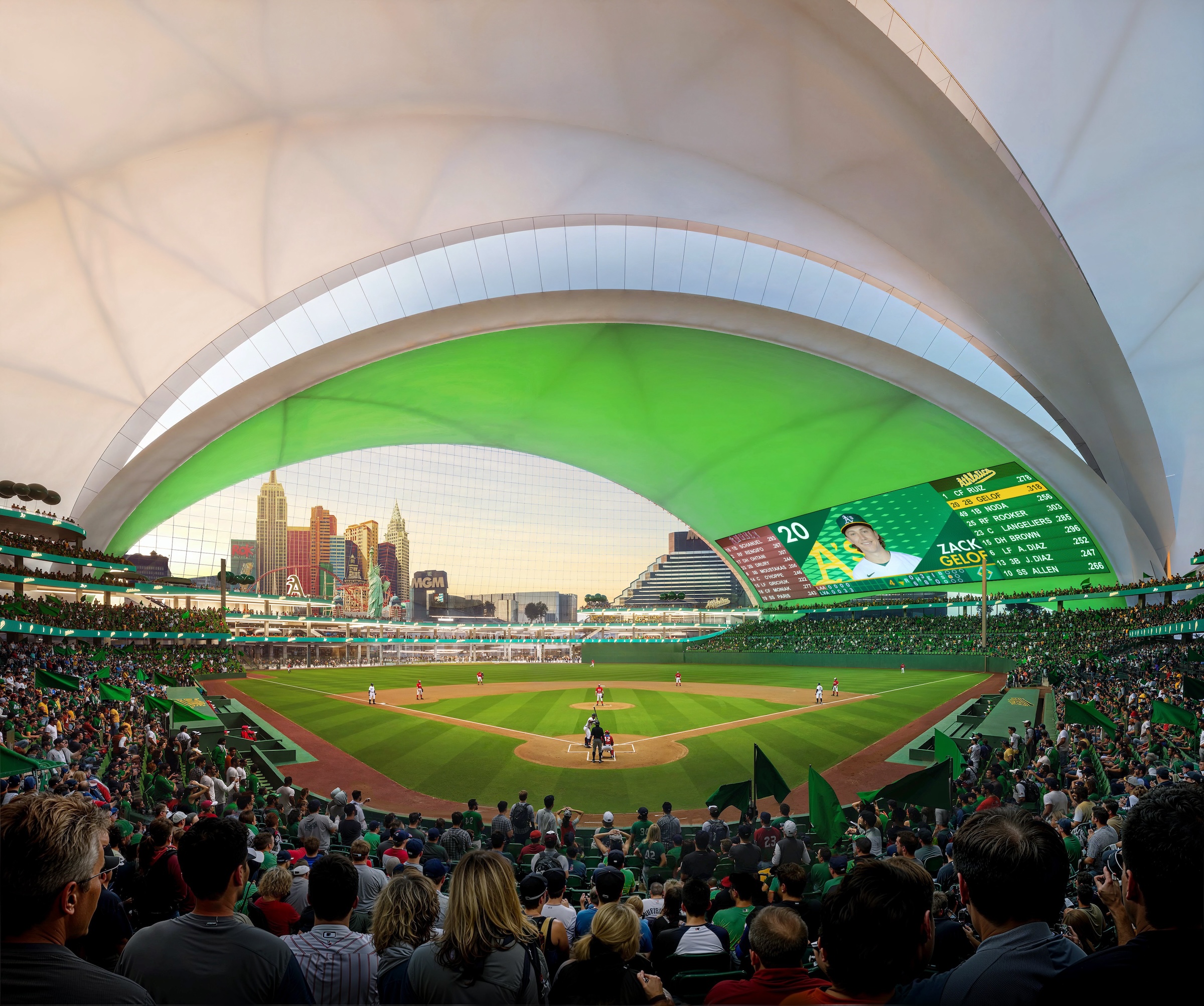Designed by Bjarke Ingels Group (BIG) in collaboration with HNTB, the new ballpark for the Oakland Athletics Major League Baseball team will be located on the Las Vegas Strip and offer panoramic views of the city skyline. The 33,000-capacity covered, climate-controlled stadium will sit on nine acres on Las Vegas Boulevard.
The A’s will relocate from Oakland, Calif., to Las Vegas in 2028. The new ballpark’s expected opening date will be in spring of that year.
BIG’s design pays homage to the sport: Five overlapping shells on the ballpark’s roof will resemble baseball pennants. The pennant-shaped arches are designed for passive shading and will maximize natural light; they will block direct sunlight glare while allowing indirect natural light through north-facing clerestory windows. In addition, the structure’s exterior metal cladding will reflect the daylight and the city’s night lights.
“The resultant architecture is like a spherical armadillo,” Bjarke Ingels, BIG’s Founder and Creative Director, said in a statement.
An elevated outdoor plaza connects with the bridges over Las Vegas and Tropicana Boulevards. The plaza directs fans to the ballpark’s main concourse and its large glass atrium. In addition to improving wayfinding and circulation, this entrance allows views of the entire field and seating bowl upon entry. Inside, open atria will serve as multipurpose exhibition spaces showcasing local and global artists.
How will the A’s open-air ballpark keep fans cool in the Las Vegas heat?
Inspired by historic ballparks such as Fenway Park and Wrigley Field, the Athletics ballpark will boast an intimate, tiered design that brings fans closer to the action than traditional ballparks and provides every seat with clear sight lines. An air-conditioning system distributes at the seats instead of from above, making cooling more efficient.
The current design features an 18,000-square-foot jumbotron, which would make it the MLB’s largest screen, as well as the world’s largest cable glass wall, according to BIG’s statement.
The Athletics Ballpark will be able to double as a venue for concerts, conferences, and other events. Potential development around the ballpark could include an onsite hotel and casino.
“Las Vegas is where the imagination runs free, characterized by bespoke, one-of-a-kind experiences. The A’s new ballpark will be filled with unique settings for the social interplay between, sport, spectacle and entertainment,” said Lanson Nichols, Principal-in-Charge, HNTB, in a statement.
On the Building Team:
Owner: Athletics
Design architect: Bjarke Ingels Group (BIG)
Architect of record: HNTB
MEP engineer: Henderson Engineers
Structural engineer: Thornton Tomasetti
General contractor: Joint venture between Mortenson and McCarthy




Check out more recent projects from Bjarke Ingels Group (BIG):
- Bjarke Ingels's curved residential high-rise will anchor a massive urban regeneration project in Greece
- Bjarke Ingels Group and Skanska to deliver 1550 on the Green, one of the most sustainable buildings in Texas
Related Stories
| Apr 11, 2011
Wind turbines to generate power for new UNT football stadium
The University of North Texas has received a $2 million grant from the State Energy Conservation Office to install three wind turbines that will feed the electrical grid and provide power to UNT’s new football stadium.
| Apr 5, 2011
U.S. sports industry leads charge in meeting environmental challenges
The U.S. sports industry generates $414 billion annually. The amount of energy being consumed is not often thought of by fans when heading to the stadium or ballpark, but these stadiums, parks, and arenas use massive quantities of energy. Now sports leagues in North America are making a play to curb the waste and score environmental gains.
| Mar 25, 2011
Qatar World Cup may feature carbon-fiber ‘clouds’
Engineers at Qatar University’s Department of Mechanical and Industrial Engineering are busy developing what they believe could act as artificial “clouds,” man-made saucer-type structures suspended over a given soccer stadium, working to shield tens of thousands of spectators from suffocating summer temperatures that regularly top 115 degrees Fahrenheit.
| Mar 11, 2011
University of Oregon scores with new $227 million basketball arena
The University of Oregon’s Matthew Knight Arena opened January 13 with a men’s basketball game against USC where the Ducks beat the Trojans, 68-62. The $227 million arena, which replaces the school’s 84-year-old McArthur Court, has a seating bowl pitched at 36 degrees to replicate the close-to-the-action feel of the smaller arena it replaced, although this new one accommodates 12,364 fans.
| Mar 11, 2011
Community sports center in Nashville features NCAA-grade training facility
A multisport community facility in Nashville featuring a training facility that will meet NCAA Division I standards is being constructed by St. Louis-based Clayco and Chicago-based Pinnacle.
| Mar 11, 2011
Slam dunk for the University of Nebraska’s basketball arena
The University of Nebraska men’s and women’s basketball programs will have a new home beginning in 2013. Designed by the DLR Group, the $344 million West Haymarket Civic Arena in Lincoln, Neb., will have 16,000 seats, suites, club amenities, loge, dedicated locker rooms, training rooms, and support space for game operations.
| Feb 23, 2011
London 2012: What Olympic Park looks like today
London 2012 released a series of aerial images that show progress at Olympic Park, including a completed roof on the stadium (where seats are already installed), tile work at the aquatic centre, and structural work complete on more than a quarter of residential projects at Olympic Village.
| Jan 21, 2011
Sustainable history center exhibits Fort Ticonderoga’s storied past
Fort Ticonderoga, in Ticonderoga, N.Y., along Lake Champlain, dates to 1755 and was the site of battles in the French and Indian War and the American Revolution. The new $20.8 million, 15,000-sf Deborah Clarke Mars Education Center pays homage to the French magasin du Roi (the King’s warehouse) at the fort.












